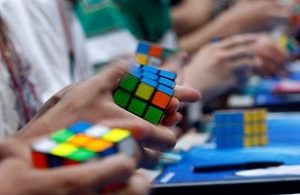Tips for Speedcubing

An important aspect of speedcubing even after learning algorithms is practice and finger tricks. If you want to learn how to solve the Rubik’s Cube, you need to practice and practice. If you are unsure of the kind of Rubik’s Cube you should own, visit https://www.cubelelo.com/. Turning layers and pieces require a whole-handed grip to physically push and pull it to the desired position.
If you have watched a professional at speed solving competition or YouTube videos, you will notice that they simply use a finger to push the layers across or two fingers to make a double move. This is a skill that can be understood by practice. The tips outlined below aim at helping you maximize your practice time for speedcubing.
Tips for Speedcubing
1. Practice only when you feel like it.

Many cube solvers practice cubing for fun and entertainment. They also love being competitive and the practice that is needed to do so. It is important to understand that cubing should not be a chore. It is imperative that you practice with the right mindset. Practising when you don’t want to will lead to frustration, and bad solve, thereby taking away the fun from speedcubing. If you are not focused and motivated, your practice sessions will not be as effective.
2. Take frequent breaks.

Don’t be afraid to take breaks from cubing. It is definitely beneficial to not cube for a short period. It said that stepping away from a task with the intention of returning to it causes subconscious processing to occur in your mind. There is no doubt that cubing is a cumulative activity. It is very hard to regress and get slower once you build up a certain skill level. Even when you take longer breaks, it will be easy for you to return to your speed.
-
Conscious and Subconscious practice.

Conscious practise is deliberate, while the subconscious practice is repetitive. Deliberate practice is when you identify and improve your overall speeding knowledge like learning and performing new algorithms, experimenting with different solutions, focusing on a certain aspect of your solve, etc.
On the other hand, repetitive practice or subconscious practice is when your sole aim is to solve the puzzle as fast as possible. With this, you can implement things that you have learnt in your conscious practice time and will become an integrated part of your solves.
If you wish to improve your solve speed and techniques, you should have an equal balance of conscious and subconscious practice.
4. Practice schedules.

You may or at tiat times, mes,may not want to follow a strict practice schedule. Like I said above, cubing should not be a chore. Let’s say that you have scheduled a practice for 5×5 Rubik’s Cube, but you are in the mood for a 3×3 solve. In such a case, your practice schedule will work against your mindset.
On the other hand, if you participate in a lot of cubing events, then you need to practice for a certain timeframe. You can consider practising for specific events held at the competition for a few weeks before it is hosted.
5. Slow progress is progress.

If you are practising the right things, then your practice is good practice. Even if your speed does not get better over a few weeks, you should not worry about it at all. Improvement is cubing happens gradually, and so you should be patient and kind to yourself. In the initial stage, you might feel that your improvement rate is quick, but as you move on to higher variants and challenging cubes, it gets a little harder to improve quickly.
Conclusion
There could be numerous times when you feel that your improvement is stagnant. But do not get discouraged. Remember that the right practice will eventually pay off. Getting slower at times is very natural, and it often happens to everyone – including the record breakers! So lay back and keep practising.
Happy Cubing!





